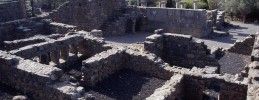Fascinating Ancient Archaeological Sites in Israel’s Golan
November 19th 2019
Some of Israel’s most fascinating and ancient archaeological sites can be found in what today is called the Golan Heights. Far back in Biblical history, the region was referred to as “Bashan” and during the First Temple era was ruled in part by the Jewish kingdom of Israel.
The modern term “Golan” is derived from the name of an ancient city in Bashan, which is mentioned in Deuteronomy (4:43). The Romans would later refer to the entire region as Golan, and the name remains to this day.
There are so many Biblical stories and later historical events associated with the Golan area, including the settlements of Babylonian exiles, the Maccabean Revolt, and the Islamic invasions. The latter of which ended Jewish presence in the Golan until the late 19th Century.
Today, there are a variety of fascinating archaeological sites to visit which explore in more detail the long and varied history of this stunningly beautiful region of Israel.
They include the:
Katzrin Talmudic Village
In the central part of the Golan, approximately 13km northeast of the Kinneret (Sea of Galilee) lie the ruins of the ancient Jewish village of Katzrin. Thought to have originally been built during the Hellenistic period (2nd century BCE), the once prosperous ancient Talmudic village had been abandoned by the 14th Century.
In the 1960s, the remains were discovered, including those of the ancient village synagogue. Today, visitors can walk around the partially reconstructed Katzrin village including courtyards and homes. Audiovisual presentations and replicas bring the past back to life.
Gamla National Park
A few kilometers to the south of Katzrin is the Gamla National Park. Known for its stunning landscapes and wide variety of flora and fauna, the nature reserve also contains a fascinating archaeological site. The ancient city of Gamla was founded by the Hasmonean ruler Alexander Yannaeus upon a camel hump-shaped hill.
Later, Josephus Flavius, Commander of Galilee during the Jewish Revolt against Rome, fortified the hilltop city. The Jewish inhabitants held out during an initial 7-month brutal siege by the Romans before being overrun and slaughtered during a second attempt. Today, you can explore the remains of this town and other ruins, as well as walk to the highest waterfall in Israel.
Tel Dan National Park
In the Galilee Panhandle, just bordering the Golan, is the Tel Dan National Park. Its natural beauty makes it a popular place for hiking but it also contains a site of biblical archaeological importance. A red sandstone gate and surrounding ruins are believed to be one of the oldest archaeological sites in all of Israel.
The gate is what remains of the ancient Biblical city of Laish, capital of the Northern Kingdom. Other gates and ruins provide fascinating insights into the history of the area, which is further revealed by informative guided tours. Shallow wading pools and canopies of greenery allow for pleasant cool rest breaks during your walks.
Nimrod Fortress
In the northern part of the Golan Heights, just a few kilometers south of Mount Hermon, is Nimrod Fortress. Named after the hunter Nimrod, a Biblical hero, the fortress overlooks a deep valley and road linking the Galilee with Damascus.
Originally constructed by Crusaders, the forested hilltop fortress was later expanded by the Muslim rulers of Damascus, before later changing hands a number of times. Visitors today can explore the remarkably preserved and partially restored fortress which provides stunningly beautiful views across the forested slopes and valley below.












